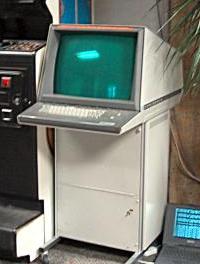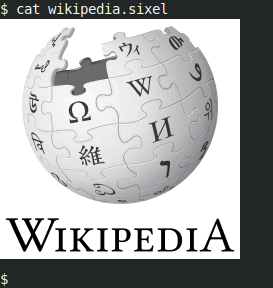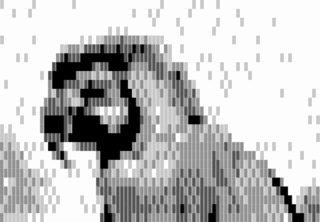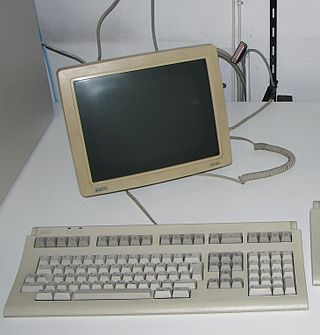
The IBM 3270 is a family of block oriented display and printer computer terminals introduced by IBM in 1971 and normally used to communicate with IBM mainframes. The 3270 was the successor to the IBM 2260 display terminal. Due to the text color on the original models, these terminals are informally known as green screen terminals. Unlike a character-oriented terminal, the 3270 minimizes the number of I/O interrupts required by transferring large blocks of data known as data streams, and uses a high speed proprietary communications interface, using coaxial cable.

A terminal emulator, or terminal application, is a computer program that emulates a video terminal within some other display architecture. Though typically synonymous with a shell or text terminal, the term terminal covers all remote terminals, including graphical interfaces. A terminal emulator inside a graphical user interface is often called a terminal window.

The VT100 is a video terminal, introduced in August 1978 by Digital Equipment Corporation (DEC). It was one of the first terminals to support ANSI escape codes for cursor control and other tasks, and added a number of extended codes for special features like controlling the status lights on the keyboard. This led to rapid uptake of the ANSI standard, which became the de facto standard for hardware video terminals and later terminal emulators.

A computer terminal is an electronic or electromechanical hardware device that can be used for entering data into, and transcribing data from, a computer or a computing system. Most early computers only had a front panel to input or display bits and had to be connected to a terminal to print or input text through a keyboard. Teleprinters were used as early-day hard-copy terminals and predated the use of a computer screen by decades. The computer would typically transmit a line of data which would be printed on paper, and accept a line of data from a keyboard over a serial or other interface. Starting in the mid-1970s with microcomputers such as the Sphere 1, Sol-20, and Apple I, display circuitry and keyboards began to be integrated into personal and workstation computer systems, with the computer handling character generation and outputting to a CRT display such as a computer monitor or, sometimes, a consumer TV, but most larger computers continued to require terminals.

The VT200 series is a family of computer terminals introduced by Digital Equipment Corporation (DEC) in November 1983. The VT220 was the basic version, a text-only version with multi-lingual capabilities. The VT240 added monochrome ReGIS vector graphics support to the base model, while the VT241 did the same in color. The 200 series replaced the successful VT100 series, providing more functionality in a much smaller unit with a much smaller and lighter keyboard. Like the VT100, the VT200 series implemented a large subset of ANSI X.364. Among its major upgrades was a number of international character sets, as well as the ability to define new character sets.
Text mode is a computer display mode in which content is internally represented on a computer screen in terms of characters rather than individual pixels. Typically, the screen consists of a uniform rectangular grid of character cells, each of which contains one of the characters of a character set; at the same time, contrasted to graphics mode or other kinds of computer graphics modes.
Attachmate Corporation is a 1982-founded software company which focused on secure terminal emulation, legacy integration, and managed file transfer software. Citrix-compatibility and Attachment Reflection were enhanced/added offerings.

The Tektronix 4010 series was a family of text-and-graphics computer terminals based on storage-tube technology created by Tektronix. Several members of the family were introduced during the 1970s, the best known being the 11-inch 4010 and 19-inch 4014, along with the less popular 25-inch 4016. They were widely used in the computer-aided design market in the 1970s and early 1980s.

xterm is the standard terminal emulator for the X Window System. It allows users to run programs which require a command-line interface.

The VT50 is a CRT-based computer terminal that was introduced by Digital Equipment Corporation (DEC) in July 1974. It provided a display with 12 rows and 80 columns of upper-case text, and used an expanded set of control characters and forward-only scrolling based on the earlier VT05. DEC documentation of the era refers to the terminals as the DECscope, a name that was otherwise almost never seen.

The VT05 is the first free-standing CRT computer terminal from Digital Equipment Corporation introduced in 1970. Famous for its futuristic styling, the VT05 presents the user with an upper-case-only ASCII character display of 72 columns by 20 rows. The VT05 was a smart terminal that provides cursor addressing using a series of control characters, one of which allows the cursor to be positioned at an absolute location on the screen. This basic system provided the basis of similar systems in the later and greatly improved VT50 and VT52 series.

Sixel, short for "six pixels", is a bitmap graphics format supported by terminals and printers from DEC. It consists of a pattern six pixels high and one wide, resulting in 64 possible patterns. Each possible pattern is assigned an ASCII character, making the sixels easy to transmit on 7-bit serial links.

The VT520 is an ANSI standard computer terminal introduced by Digital Equipment Corporation (DEC) in 1993 and 1994. The VT520 is a multi-session monochrome text-only terminal with a built-in 14" monitor. The VT510 was a single-session version, while the VT525 added color support and used a separate external monitor.

A monochrome monitor is a type of computer monitor in which computer text and images are displayed in varying tones of only one color, as opposed to a color monitor that can display text and images in multiple colors. They were very common in the early days of computing, from the 1960s through the 1980s, before color monitors became widely commercially available. They are still widely used in applications such as computerized cash register systems, owing to the age of many registers. Green screen was the common name for a monochrome monitor using a green "P1" phosphor screen; the term is often misused to refer to any block mode display terminal, regardless of color, e.g., IBM 3279, 3290.
ReGIS, short for Remote Graphic Instruction Set, is a vector graphics markup language developed by Digital Equipment Corporation (DEC) for later models of their famous VT series of computer terminals. ReGIS supports rudimentary vector graphics consisting of lines, circular arcs, and similar shapes. Terminals supporting ReGIS generally allow graphics and text to be mixed on-screen, which makes the construction of graphs and charts relatively easy.

Text-based semigraphics, pseudographics, or character graphics is a primitive method used in early text mode video hardware to emulate raster graphics without having to implement the logic for such a display mode.

The VT320 is an ANSI standard computer terminal introduced by Digital Equipment Corporation (DEC) in 1987. The VT320 is the text-only version, while the VT330 adds monochrome ReGIS, Sixel and Tektronix 4010 graphics, and the VT340 adds color.
The VT1000 was a monochrome X Window System computer terminal introduced by Digital Equipment Corporation (DEC) in April 1990. The VT1200 replaced the VT1000 later that year, consisting of a code update and a bump in the RAM from 1 to 2 MB. All of the VT1000 series communicated with their host computers over Ethernet, supporting TCP/IP as well as DEC's terminal-oriented Local Area Transport (LAT) protocol. They also included standard serial ports to allow basic terminal emulation, built into the ROM.

DEC Special Graphics is a 7-bit character set developed by Digital Equipment Corporation. This was used very often to draw boxes on the VT100 video terminal and the many emulators, and used by bulletin board software. The designation escape sequence ESC ( 0 switched the codes for lower-case ASCII letters to draw this set, and the sequence ESC ( B switched back. IBM calls it Code page 1090.
DEC Technical (TCS) is a 7-bit character set developed by Digital Equipment Corporation.














